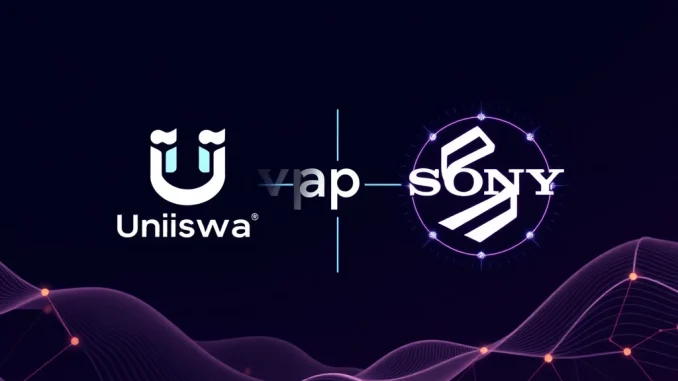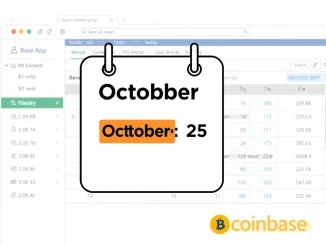
The world of decentralized finance (DeFi) just received a notable upgrade. Uniswap, a leading **Decentralized Exchange Uniswap**, has officially announced a significant **Uniswap Soneium integration**, bringing Sony Group’s Layer-2 blockchain, Soneium, directly into its platform. This strategic move is set to transform the trading experience for users, promising greater efficiency and accessibility.
What Does the Uniswap Soneium Integration Enable?
Announced via Uniswap’s official X account, this integration is more than just a simple connection. It allows users to interact with the Soneium network directly through familiar Uniswap interfaces:
- Swapping: Execute token swaps on the Soneium network with potentially lower fees and faster confirmation times compared to Layer 1.
- Bridging: Move assets between Soneium and other supported networks seamlessly within the Uniswap Web App. This simplifies the process of accessing liquidity across different blockchain environments.
- Liquidity Provision: Provide liquidity to trading pairs on the Soneium network, contributing to the ecosystem and potentially earning fees.
Access to these features is available through the main Uniswap Web App and the latest version of the Uniswap Wallet, making it convenient for existing users.
Exploring Soneium Layer 2: Sony’s Web3 Ambition
What exactly is **Soneium Layer 2**? Developed by Sony Group, Soneium represents the tech giant’s venture into the blockchain space, specifically focusing on Layer 2 scaling solutions. Layer 2 networks are built on top of Layer 1 blockchains (like Ethereum, which Uniswap primarily operates on) to handle transactions off the main chain. This significantly increases transaction throughput and reduces costs.
Sony’s interest in Web3, particularly in areas like gaming, entertainment, and digital collectibles, positions Soneium as a potential backbone for future decentralized applications within their ecosystem. Integrating with a major DEX like Uniswap provides Soneium immediate access to a vast user base and established DeFi infrastructure.
Benefits for Uniswap Trading and Users
The primary beneficiaries of this integration are users engaging in **Uniswap trading**. Layer 2 solutions address some of the most significant pain points of Layer 1 trading, namely high transaction fees (gas costs) and network congestion during peak times.
By leveraging Soneium, Uniswap users can expect:
- Reduced Costs: Transactions on Layer 2 networks are typically much cheaper than on Layer 1. This makes frequent trading, smaller swaps, and interacting with DeFi protocols more economical.
- Increased Speed: Layer 2 chains process transactions faster, leading to quicker confirmations for swaps and other operations.
- Enhanced Scalability: The integration helps Uniswap handle more transactions overall, improving its capacity and resilience.
This move aligns with the broader industry trend of DEXs embracing Layer 2 scaling to provide a better user experience and onboard more participants into DeFi.
The Impact on the Decentralized Exchange Uniswap Ecosystem
For the **Decentralized Exchange Uniswap**, adding Soneium is a strategic win. It expands Uniswap’s multi-chain capabilities, attracting users and projects specifically building on Soneium. This diversifies Uniswap’s liquidity and volume sources beyond its core Ethereum and existing Layer 2 deployments.
The integration also signals Uniswap’s willingness to work with diverse blockchain initiatives, including those backed by large corporations like Sony. This could open doors for future collaborations and further solidify Uniswap’s position as a leading platform in the evolving multi-chain DeFi landscape.
Seamless Crypto Bridging and Liquidity Provision
A key feature enabled by the integration is simplified **Crypto bridging**. Moving assets between different blockchains has often been a complex process involving external bridges. By integrating Soneium directly, Uniswap provides a more unified experience for users looking to transfer assets to or from the Soneium network.
Liquidity providers also benefit. Lower transaction costs on Soneium make it cheaper to manage liquidity positions, add or remove liquidity, and potentially implement more complex strategies. This could encourage more participation in providing liquidity on the Soneium network via Uniswap.
Getting Started: How to Use the New Integration
Accessing the Soneium network on Uniswap is straightforward for users familiar with the platform:
- Navigate to the Uniswap Web App or open the Uniswap Wallet.
- Connect your compatible cryptocurrency wallet.
- Look for the network selection option (usually near the top).
- Select ‘Soneium’ from the list of available networks.
- Once connected to Soneium, you can proceed to swap tokens, bridge assets, or add/remove liquidity as you normally would on Uniswap.
Always ensure you have the native token for gas fees on the Soneium network (if applicable) and understand the specific tokens available on that layer.
Challenges and Opportunities for Layer 2 DEXs
While the **Layer 2** integration brings significant benefits, challenges remain. Educating users about Layer 2 nuances, managing liquidity fragmentation across different layers, and ensuring the security of bridges are ongoing efforts in the multi-chain world. However, the opportunity for mass adoption and truly scalable DeFi outweighs these challenges.
Conclusion
The **Uniswap Soneium integration** marks an important step for both platforms. For Uniswap, it enhances its multi-chain offering and provides users with a faster, cheaper trading experience via a new, enterprise-backed Layer 2. For Soneium, it gains immediate exposure to a large DeFi user base. This collaboration highlights the increasing importance of Layer 2 scaling in making decentralized finance more accessible and efficient for everyone.



